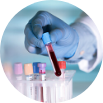

Day
12-15
12-15
Liposomal Amphotericin B initiated
Decision point
Why Liposomal Amphotericin B

Due to the lack of response to treatment, and given
the blood cultures obtained after six days of
antifungal treatment remained positive, Liposomal
Amphotericin B was initiated.
the blood cultures obtained after six days of
antifungal treatment remained positive, Liposomal
Amphotericin B was initiated.
Clinical findings remained unchanged; however,
the surgical wound appeared slightly inflamed.
the surgical wound appeared slightly inflamed.


Due to non-response, Abdullah’s antifungal
treatment was switched to Liposomal
Amphotericin B (3 mg/kg/day).*
treatment was switched to Liposomal
Amphotericin B (3 mg/kg/day).*
After three days, there was still no sign of a
therapeutic response and Abdullah remained
febrile. Clinically, there were no other
explanations for his fever other than the
Candida infection, so the Liposomal
Amphotericin B dose was increased to
5 mg/kg/day.**
therapeutic response and Abdullah remained
febrile. Clinically, there were no other
explanations for his fever other than the
Candida infection, so the Liposomal
Amphotericin B dose was increased to
5 mg/kg/day.**

Result

*Administration of a test dose is advisable before a new course of Liposomal Amphotericin B treatment. Therapy is usually instituted at a daily
dose of 1.0 mg/kg of body weight and increased stepwise to 3.0 mg/kg as required. Data are presently insufficient to define total dosage
requirements and duration of treatment necessary for resolution of mycoses. Dosage of amphotericin B as Liposomal Amphotericin B must
be adjusted to the specific requirements of each patient.13
dose of 1.0 mg/kg of body weight and increased stepwise to 3.0 mg/kg as required. Data are presently insufficient to define total dosage
requirements and duration of treatment necessary for resolution of mycoses. Dosage of amphotericin B as Liposomal Amphotericin B must
be adjusted to the specific requirements of each patient.13
**Doses above 5 mg/kg/day have been explored and used in clinical settings; however, data on the safety and efficacy of Liposomal
Amphotericin B at these higher doses are limited. Therefore, a benefit:risk assessment should be made on an individual patient level to
determine whether the potential benefits of treatment are considered to outweigh the known increased risk of toxicity at higher
Liposomal Amphotericin B doses.
Amphotericin B at these higher doses are limited. Therefore, a benefit:risk assessment should be made on an individual patient level to
determine whether the potential benefits of treatment are considered to outweigh the known increased risk of toxicity at higher
Liposomal Amphotericin B doses.





